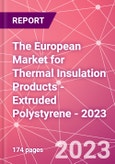This report examines the European market for thermal insulation products and their different uses in building and in industry, as well as identifying key trends impacting the industry.
Thermal Insulation Materials Overview
Various factors affect the type and amount of thermal insulation required. These can include:
- Climate
- Durability
- Ease of installation and replacement at end of life
- Cost effectiveness
- Toxicity
- Flammability
- Environmental impact and sustainability
- Energy efficiency
Extruded Polystyrene (XPS)
For extrusion, polystyrene with a high viscosity is most suitable, i.e., products with a melt volume index (MVI) of 200/5 in the lower end of the range between 1 and 7 ml/10min.
The physical properties of XPS mean that it can be used in board form in roofing, flooring and walling applications. The low moisture absorption of the material makes it ideal for use in cold storage facilities and refrigerated transport, where it is subjected to freeze/thaw cycles. The high compressive strength of the material also makes it ideal for load bearing applications. XPS does not rot and has relatively high thermal insulation properties.
Due to its cost, XPS tends to be used in specialist areas where its properties are specifically required.
End-Use Sector Definitions
For the purpose of this study, the end-use sectors have been split into building and industrial.
Building
This sector includes commercial and domestic building, cold storage and agricultural storage. The building sector generally takes up to 90% of volume (m3) of the insulation market.
Domestic building is split into flooring, roofing and wall insulation. Thermal insulation for domestic pipe work and air conditioning applications are not included in the building market figures. It was found that some respondents could not separate heating and ventilation figures for domestic and commercial buildings from the usage in industrial buildings and process plant. There is therefore some overlap in the definitions used by the trade. This approach of combining both sectors into a unique pipe lagging market eliminates double counting.
Industrial
This sector consists of the following:
- Pipe lagging: This includes the thermal lagging of industrial pipe work, ducts and plant. Where domestic pipe work has been identified this is also included, as well as insulation of district heating pipes.
- Process Plant and Machinery: This section includes all applications in process plant (except the lagging of pipe work and ducts) and in ancillary equipment. A special feature of this end-use sector is the requirement for very high temperature insulation in furnaces, ovens, etc.
- Domestic and Commercial Appliances: This sector covers refrigerators, freezers, cookers and storage and other heaters. Market figures exempt other minor uses, such as irons and commercial presses.
- Transport: Road, rail, and sea transport is considered. Applications include the production of refrigerated vehicles and boatbuilding.
Countries covered: Austria, Baltics (Estonia, Latvia and Lithuania), Belgium, Bulgaria, Croatia, Czech Republic, Denmark, Finland, France, Germany, Hungary, Ireland, Italy, Netherlands, Norway, Poland, Portugal, Romania, Russia, Slovakia, Slovenia, Spain, Sweden, Switzerland, Turkey, UK
Table of Contents
1. Introduction - XPS
Companies Mentioned (Partial List)
A selection of companies mentioned in this report includes, but is not limited to:
- Armacell
- BASF
- Bauder
- Dow Chemical
- DuPont
- HIRSCH Porozell
- Kingspan
- Knauf Insulation
- Owens Corning
- Ravago
- Recticel
- Rockwool
- Saint-Gobain Isover
- Unilin
Methodology
Information provided in these reports are based on existing in-house data and an extensive programme of interviews with leading product manufacturers, trade associations, distributors and raw materials producers involved with the specific market researched. These interviews are conducted within the 3-6 months leading up to the publication of the study, with the duration of the research programme and the number of interviews completed depending on the scope of the study. The analyst publishes both regional and global reports, and in most cases, the interviews are conducted in the native language of the individual respondents.
In addition, published data and statistics are also reviewed in order to produce as accurate figures as possible for size of markets studied. Market forecasts are based upon industry and economic forecasts as well as upon other relevant commercial and technical issues likely to affect individual market sectors and products, as well as the interviews conducted for the study.

LOADING...








